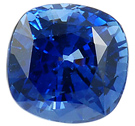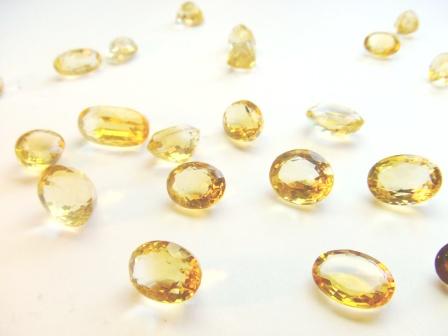| Color |
Blue, yellow, green, white, colorless, pink, orange, brown, and purple |
| Hardness |
9 |
| SG |
3.9 - 4.1 |
| RI |
1.76 - 1.77 |
| DR |
.0008 |
| Luster |
Vitreous to adamantine |
 |
| Mineral class |
Corundum |
| Composition |
Al2O3 |
 In the gem trade, sapphire refers to the blue variety of corundum. However, excluding red ruby, it scientifically encompasses all other gem varieties of corundum. (In essence, ruby is really a red sapphire, since ruby and sapphire are identical in all properties except color.)
In the gem trade, sapphire refers to the blue variety of corundum. However, excluding red ruby, it scientifically encompasses all other gem varieties of corundum. (In essence, ruby is really a red sapphire, since ruby and sapphire are identical in all properties except color.)
Sapphire is the most precious of blue gemstones. It is a most desirable gem due to its color, hardness, durability, and luster. The most valuable color of sapphire is cornflower blue, known as Kashmir sapphire or Cornflower blue sapphire.
See some examples of Fine Quality Cornflower Blue Sapphires from our partner AfricaGems.com.
Until the last century, all sapphires (excluding blue) were called the same name as a popular gemstone of that color with the prefix "oriental" added to it. For example, green sapphire was known as "oriental emerald". The practice of applying the name of a different gemstone to identify the sapphire was misleading, so these names were virtually abolished. What was once called "oriental emerald" is now called "green sapphire". The same holds true for all other color varieties of sapphire. However, the word "sapphire" in its plain context refers only to blue sapphire, unless a prefix color is specified. Sapphire with a color other than blue is often called a "fancy" in the gem trade.
Inclusions of tiny, slender, parallel Rutile needles cause polished sapphire gems to exhibit asterism. Sapphire gems displaying asterism are known as "star sapphires", and if transparent are especially prized. Star sapphires are usually in six ray stars, but twelve ray stars are also known. Very rarely, sapphire also exhibits cat's eye effect.
Color zoning, which forms from growth layers that build up during the formation of the stone, is present in certain sapphires. However, uniformity of color is an important factor in a sapphire's value.
Colorless and pale blue sapphires from certain localities may be heat-treated to give them an intense blue color. Heat-treatment may also improve the clarity of some sapphires by removing tiny inner inclusions. Sapphire is pleochroic, displaying a lighter and more intense color when viewed at different angles. Some pleochroic sapphire is blue when viewed at one angle, and purple at a different angle.
A rare variety of sapphire, known as color changing sapphire, exhibits different colors in different light. In natural light, color changing sapphire is blue, but in artificial light, it is violet. This effect is the same phenomenon seen in alexandrite.
Sapphire was first synthesized in 1902. The process of creating synthetic sapphire is known as the Verneuil process. Only experts can distinguish between natural and synthetic sapphire.
Sapphire is a tough and durable gem, but it is still subject to chipping and fracture if handled roughly.

USES
Sapphire is one of the most popular jewelry stones. The blue variety is most often used in jewelry, but the yellow, pink, and orange stones are also popular. A rare orange-pink variety, known as padparadschah, is even more valued than blue sapphire.
Stones displaying asterism are polished as cabochons, and, if clear, are extremely valuable. Blue sapphire is sometimes carved into cameos or small figures. Synthetic sapphire is often used as a substitute for the natural material.
Sapphire is the birthstone of September.
VARIETIES
 Kashmir Sapphire - Sapphire with a distinct velvety-blue color
Kashmir Sapphire - Sapphire with a distinct velvety-blue color
 Cornflower Sapphire - Synonym of Kashmir sapphire (above)
Cornflower Sapphire - Synonym of Kashmir sapphire (above)
 Cornflower Blue Sapphire - Synonym of Kashmir sapphire (above)
Cornflower Blue Sapphire - Synonym of Kashmir sapphire (above)
 Star Sapphire - Sapphire displaying asterism
Star Sapphire - Sapphire displaying asterism
 Padparadschah - Orange-pink variety of sapphire
Padparadschah - Orange-pink variety of sapphire
 Color Changing Sapphire - Sapphire exhibiting a different color in natural and artificial light
Color Changing Sapphire - Sapphire exhibiting a different color in natural and artificial light
 Bi-colored Sapphire - Sapphire with more than one color
Bi-colored Sapphire - Sapphire with more than one color
 Cat's Eye Sapphire - Sapphire exhibiting cat's eye effect
Cat's Eye Sapphire - Sapphire exhibiting cat's eye effect
 Fancy Sapphire - Any sapphire with a color other than blue
Fancy Sapphire - Any sapphire with a color other than blue
 Verneuil Sapphire - Synthetic, laboratory-grown sapphire
Verneuil Sapphire - Synthetic, laboratory-grown sapphire
Nowadays, sapphire is classified by its color in the gem trade (i.e. green color sapphire is "Green Sapphire"). Colorless sapphire is usually called "White Sapphire".